Let me just take you through this past week. There will be pictures, in real time. It is the time of year when I could write a chapter every day.
Let me start with a splash. This bloomed late in the week, a full month before it will get to go in the ground.
Sunday
I found the new slipper orchid coming up in the front sidewalk bed. It is another Gisela. The large clump in the backyard is also Gisela. That is not a coincidence. That large clump looks to have perhaps 11 shoots coming up. The front yard plant does seem to be right next to a bloodroot. I must confess that I do not have all the bloodroot labeled.
The double bloodroot big clump is emerging.
I suppose I will have to see if either of these wonderful plants are "deer resistant."
Here is a picture of the emerging orchid clump. It is getting to the point when I ask when could I divide them. (I added the picture of the Iceland poppy at the top of the post, since this picture, while exciting, was not necessarily the way to open the story of an exciting week.)
I do want to have a short discussion about those little blue spring flowers that I think of as scilla or squill. They carpet parts of the yard, after the yellow waive of aconite is finished. They are best right at this time. I have always called them silla or squill.
I remember a few weeks ago when Christopher came running up to me to announce that there was the first blue flower. There are now many thousands more.
When I look them up on the computer they are marketed as Siberian scilla. That would be "Scilla siberica" if you want to go all Latin. They are also called spring beauty. Then we saw a wildflower yesterday (Saturday) that is called "spring beauty".
Guess what? These scilla are deer resistant. They do not taste good. As I drive around the neighborhood I find a few yards that have managed to carpet their "lawn" with these blue flowers. I have a few that are starting in the part of the front yard where there is grass. Calling it a "lawn" does not seem right.
There are also other scillas. What I think of as an English hyacynth is or was at one time called a scilla campanulata. They will bloom in maybe 3 weeks.
https://www.longfield-gardens.com/article/All-About-Scilla
A plant I call puschkinia is a cousin of the scilla siberica.
It can be white. It faces upwards. Pictures further on.
Monday
School started for Christopher and Maisie in Maine. Christopher was going back to school. This was all new for Maisie. I understand the experience got better as the week went along.
Back here is Iowa...
Let me start by saying a few words about inside plants. They are so important for almost half the year.
I grow orchids. This past winter I grew this wonderful paphiopedilum.
It started to bloom right about the time Katie and family arrived on January 23.
It bloomed for two months. I found a webcite that explained that these orchids were easily grown, cared for like African violets. I am not so sure. Whether I can make it rebloom will be the trick.
The flower is now ended. But before the spent flower is snipped away it gave us this wonderful piece of art.
Other "indoor plants" are some bulbs I overwinter. Those include amaryllis and calla lilies.
They come inside in the fall and the operative goal is "dormant." You want them to completely go to sleep until you wake them up. They go in a cool dark place, which happens to be under the basement stairs. I actually like to keep the amaryllis dormant until springtime. I wake them up and actually plant them in the garden. There is nothing quite as showy as several amaryllis blooming in the outside garden at the same time.
You wake them up by getting them out of their cool dark place and giving them dirt and water and some fertilizer. That is the theory.
It turns out they have minds of their own. (Or something like that.)
Even in the dark and relative cool, they will wake up and start to grow. If you do not get them out of the dark there will be some serious plant abuse, as they grow without photosynthesis. (The grow leggy and all white- it is rather ugly.)
So I try to check down there under the stairs every month or so.
It is so important to look in all the corners of a garden just to check.
I checked yesterday.
Four amaryllis bulbs, the larger ones, had set a bud and were just emerging.
Then there were the calla lilies. These are in their third year, having been acquired in 2019.
But I guess it is their time.
Neither of these bulbs can go outside until the danger of frost is over. It is to get into the mid 20's Wednesday night. We are a long way from the frost free date which is early May.
I will have to figure out what to do with them. They should not live in peat moss for a month.
Wednesday
The rest of the week was rather a blurr. It got chilly, with one night getting down to 23 degrees. We had a fire in the fireplace. In the garden it was an experiment in survival. Sure enough, everything that was already up, was hurt by the short freeze.
The hellebores bend way over when it gets below freezing. They will pop right back up after it warms. If you want to know if there was a frost in the garden you can look at the hellebores.
I mentioned that other scilla. Here is a picture where it has naturalized. That is plant talk for growing everywhere. I have seen it in some 'lawns". It is particularly nice when mixed with the blue scilla.
I think this little whitish bulb is sometimes called and sold under the name scilla mischtschenkoana.
I know it as puschkinia. It is also sold under that name.
The blue scilla, like the winter aconite earlier in the season, flows around the yard. It starts up by the house, where the ground is a few degrees warmer than elsewhere.
It has now reached the foot of the back yard, back by the driveway.
It is almost solid.
I look around at places in the yard that seem so bare, with one little bulb or another.
Thursday
The first bulb catalog arrived. I am waiting for the ones that sell you plants "wholesale." That mostly means in large quantities. I think I want to get another thousand winter aconite.
Friday
It is still that wonderful time of the year when you discover missing plants that are just showing up. I moved an underperforming fern leaf peony last summer. It had not been getting enough sun. I looked for it a week or so ago, where I thought I had planted it, and I could not find it.
Well, I found it, right about where I planted it. Fancy that.
Saturday
70 degrees and sunny. Not a cloud in the sky.
There are so many things that were new.
The bloodroot bloomed, both a single flower and a double.
This opened in the back yard in the afternoon.
This is in a clump of about twenty buds. It will be really good in a few days.
I reviewed the backup clump.
Trying the find the correct verb tense when you are publishing something at the end of the week, which is suppose to be a daily reflection, is difficult.
Julia's receipe
Leeks and mushrooms and pasta
There are several pasta recipes which feature cooking the pasta in a smallish amount of water or stock with the rest of the ingredients already in the pot: a one-pot pasta dish. I made an angel hair spaghetti dish along these lines a few months ago. I like this one better, partially because shape pasta (as opposed to long pasta) works better in this kind of application. This recipe is modified from a recipe on the NYT cooking website.
When the children were young, they had a Betty Crocker kids cookbook. By the time they hit late grade school-junior high school, they regularly cooked dinner (together) once a week. I translated some recipes for them (they made an excellent moussaka, for example), and they also cooked some from their own cookbooks. There was a one-pot version of spaghetti and meatsauce in the Betty Crocker kids cookbook that was pretty good and at some point I will make and post it. In the meantime, this dish could stand alone or it could be a side dish to a simple protein.
The ingredients:
We had baked salmon with a mayo/mustard topping, broccoli and the pasta dish. The sour cream was a nice tangy contrast. Everything is better with sour cream.
The NYT receipe used smaller amounts of leeks and mushrooms and wanted ricotta instead of sour cream.
I think one could use even more leeks and mushrooms and it would be delicious. And I prefer sour cream.
Odds and Ends
The sky is brightening and this blog is a little late. It is to be another warm sunny day.
There are so many still things to say.
The first hosta are coming up.
The lilium are joining them.
It is so important to remember that different plants come up at different times.
The City garden plot should open later this week.
It will be time to start some lettuce and maybe the ornamental kale.
The Iowa legislature is almost done for the year.
Be safe.
Stop by if you are in the neighborhood.
Let me hear from you.
What is new in your garden?
Philip



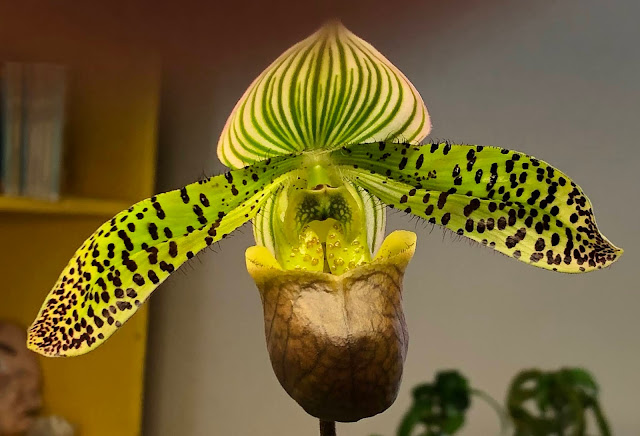



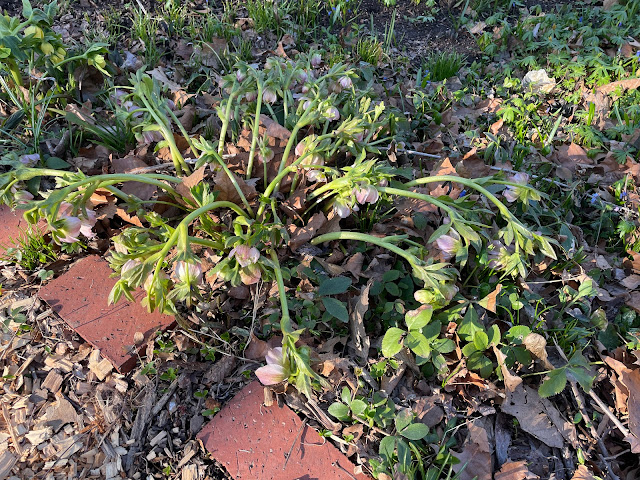



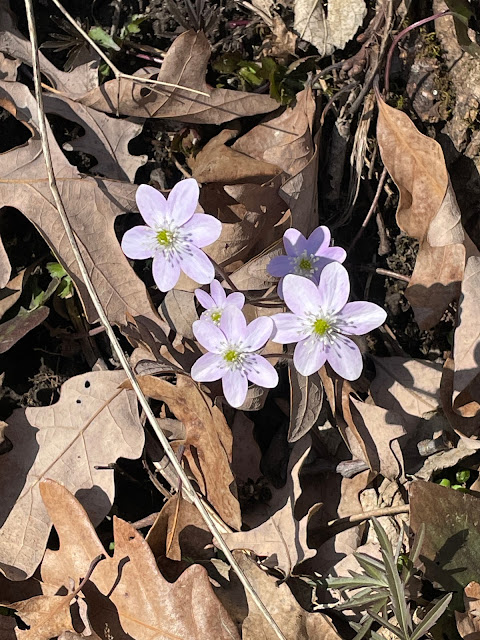




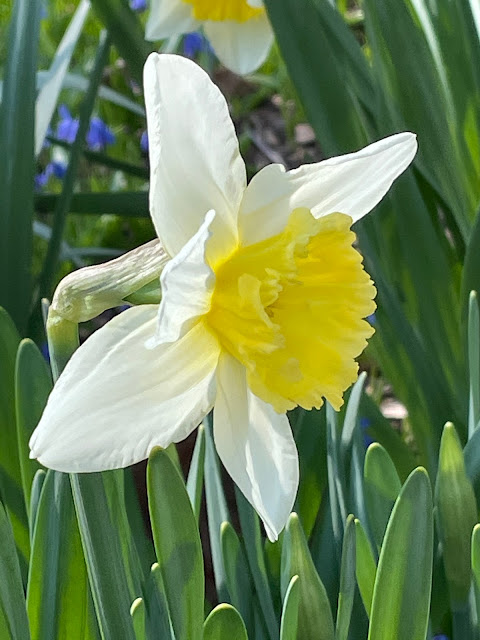











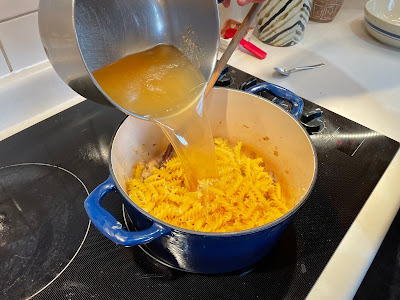


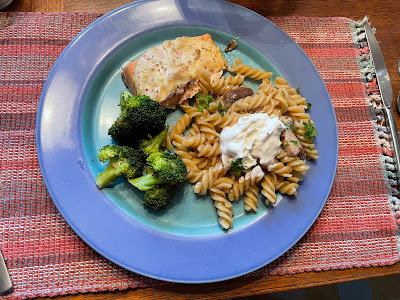
3 comments:
What's new in my garden is that the orchids are all popping. These aren't terrestrial orchids--they're epiphytic, and hang in the air here in Florida, usually in baskets made of wide wooden slats. Many varieties, but they all like to bloom at once.
That dinner looked spectacular, Julia. You're right--anything is better with sour cream. Especially pasta!
I see you have a nice wooden bench in the garden path. On warm evenings, do you ever go out after dinner and just sit and gaze? Or are you always prompted to jump up and pull out a weed?
That was from Pat, in case you hadn't guessed.
There’s news in the Feldman garden, too. A friend gave me a mini-cactus as a thank-you gift. I didn’t have the heart to tell her that I have killed every plant that has come my way. I’m pleased to say that it has broken my previous record and has now survived for a whole two months. I’ll hold off a while on starting a gardening blog.
DF
Post a Comment